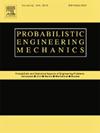An efficient strategy for information reuse in probability density evolution method considering large shift of distributions with multiple random variables
IF 3
3区 工程技术
Q2 ENGINEERING, MECHANICAL
引用次数: 0
Abstract
The probability density evolution method (PDEM) is a versatile approach for analyzing stochastic dynamical systems. When combined with the change of probability measure (COM), it provides a tool to efficiently deal with the aleatory and epistemic uncertainties, where shifts of probability distributions are frequently encountered. However, when the shifts of distributions are too large, the PDEM-COM method can lead to increasing numerical errors. This paper aims to propose an extension of the PDEM-COM that can address the large shifts of distributions involving multiple random variables. In the proposed method, the concepts of the multi-dimensional augmented support and the augmented probability density function (PDF) are introduced based on the differences between the original and updated distributions. Then, an efficient numerical procedure is established for selecting a small set of additional representative points based on the augmented PDF. These additional representative points serve as a complement to the representative point set selected according to the original distributions. By incorporating the augmented representative point set and solving the generalized probability density evolution equation (GDEE), the stochastic response of the system considering the updated distributions can be evaluated. Numerical examples are presented to demonstrate the capability and effectiveness of the proposed approach. The results demonstrate that the proposed approach offers improved accuracy compared to the PDEM-COM method, particularly for large distribution shifts, while maintaining a relatively lower computational cost.
求助全文
约1分钟内获得全文
求助全文
来源期刊

Probabilistic Engineering Mechanics
工程技术-工程:机械
CiteScore
3.80
自引率
15.40%
发文量
98
审稿时长
13.5 months
期刊介绍:
This journal provides a forum for scholarly work dealing primarily with probabilistic and statistical approaches to contemporary solid/structural and fluid mechanics problems encountered in diverse technical disciplines such as aerospace, civil, marine, mechanical, and nuclear engineering. The journal aims to maintain a healthy balance between general solution techniques and problem-specific results, encouraging a fruitful exchange of ideas among disparate engineering specialities.
 求助内容:
求助内容: 应助结果提醒方式:
应助结果提醒方式:


